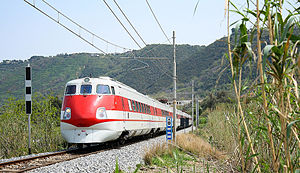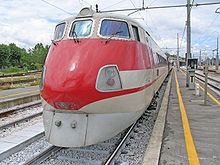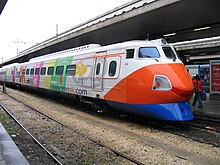FS ETR 450
| FS ETR 450 | |
|---|---|
|
ETR 450.06, on the way in Calabria
|
|
| Numbering: | ETR.450.001 - ETR.450.030 |
| Number: | 15th |
| Manufacturer: |
Fiat Ferroviaria SpA Ercole Marelli SpA |
| Year of construction (s): | 1985-1992 |
| Retirement: | 2015 |
| Axis formula : | (1A) '(A1)' (eight parts) + 2'2 ' for an intermediate car |
| Genre : | Multiple unit train |
| Gauge : | 1435 mm ( standard gauge ) |
| Length: | 234,000 mm (nine parts) |
| Height: | 3,297 mm |
| Width: | 2,750 mm |
| Trunnion Distance: | 18,900 mm |
| Bogie axle base: | 2,450 mm |
| Empty mass: | 435 t (nine parts) |
| Wheel set mass : | 12 t |
| Top speed: | 250 km / h (see text) |
| Hourly output : | 5,568 kW (eight parts) |
| Continuous output : | 5,008 kW (eight parts) |
| Starting tractive effort: | 190 kN |
| Driving wheel diameter: | 890 mm |
| Impeller diameter: | 890 mm |
| Power system : | 3 kV = |
| Number of traction motors: | 16 (eight parts) |
| Drive: | electrical, overhead line |
| Translation levels: | 34/63 |
| Seats: | 390 seats: 126 1st class 264 2nd class (nine-part) |
The ETR 450 (from Italian E lettro T reno R apido ) or "Electric Express Train " was a tilting train produced by Fiat Ferroviaria (now part of the Alstom Group) and Ercole Marelli and operated by Trenitalia ( FS ), which was ordered in 1984 and with the summer timetable in 1988 on the route Rome – Milan began its service.
technology
The multiple units were derived from the prototype railcar FIAT Y 0160 built in 1971 and the electromotive predecessor ETR 401 manufactured in 1975 (the world's first train with active hydraulic tilting technology, used occasionally until 2000) and consisted of nine parts, two control cars as end cars and seven intermediate cars. The ETR 450 represented the second "Pendolino" generation. It retained the appearance and the most important dimensions of its predecessor, the ETR 401, but differed significantly from it in some technical details due to further developments. The rather narrow and low wagons could only accommodate 3 seats side by side in the transverse direction (2 + 1 seating).
The main difference in the electrical part was the introduction of power electronics . While the electric motors were still fed with 3,000 volts direct current , the speed control was carried out using a so-called chopper instead of a rheostat . The power transmission to the tilt drives in each car took place via an electro-hydraulic support with central control. The incline was 8 ° (a maximum of 10 ° is possible), the pantographs did not incline.
In technical terms, the train could reach a speed of 280 km / h on a level stretch. In normal operation, speeds of up to 250 km / h were originally permitted, curves were traversed around 25 to 30% faster due to the side slope. This performance is made possible by a low axle load of around 12 tons and underfloor motors distributed over the train (two per wagon, each acting on a bogie wheel set). With the introduction of the ETR 450, Italy was the second country in Europe (after France with the TGV ) in which train traffic exceeded the average value of 200 km / h during travel time. As a result, it was possible to reduce the travel time between Rome and Milan from 4 hours and 55 minutes to 3 hours, 58 minutes, i.e. around 20%, with Intercity trains. As a result of the 1989 financial year, with 1,500,000 kilometers covered by the "Pendolini" fleet, there was a single failure (without interruption of operations). At the time, a picture of an older E.626 locomotive pulling a defective new ETR was circulating in the press , which raised questions about reliability. It can be stated that in the operating results of the first six years, statistically speaking, only 0.78 errors per million kilometers occurred, compared to 13 errors per million for the E.633 series locomotives, which were also quite new at the time .
commitment
After field trials on April 20, the 1988 summer timetable began regular operation of two pairs of ETR 450s on May 29 as the best train service on Italian rails with the direct connection Rome - Milan in under four hours. With simultaneous departure from Rome and Milan, at 7 a.m. and 7 p.m., 240 seats were available. Initially driven in a six-part first-class configuration, since 1993 a division into three first-class wagons with the remaining second-class wagons has been selected.
During the winter of 1988/1989, the deployment of further units could be extended to Turin and Naples . The trains were gradually lengthened with intermediate cars so that up to 340 passengers could be carried. Non-powered dining cars were added later. In the summer of 1989, connections to Venice , Salerno and Bolzano were introduced from May .
In the early 1990s, the "Pendolini" services became one of Italy's leading connections. From Rome ETR 450 went to Milan, Turin , Bolzano, Venice, Bari , Lecce , Reggio Calabria , Potenza , Taranto , Genoa , La Spezia , Vicenza and Savona . Trains also ran from Milan to Ancona and Pescara .
In 1991 and 1992, for example, the missions also went over the weekends between Milan and Ancona, with stops in Bologna , Cesena , Rimini , Riccione , Cattolica , Pesaro and Senigallia , as well as the destination Rome-Rimini. Departure was on Friday afternoon and arrival on Sunday evening. The journey between Milan and Senigallia took only three hours, the following year only 18 minutes longer, which was very popular with travelers. After conversion, the 15 sets were finally brought to nine parts with 390 seats.
In the new millennium
Due to difficulties in the procurement of the gyroscopic sensors, which were no longer manufactured by British Aerospace , but were patented and not available anywhere else, the tilting technology was gradually deactivated, depriving the “Pendolini” of its technical advantages. Ultimately, from June 10, 2004, the units were now in rank C , with a reduction in top speed to 200 km / h, after only 220 km / h had been allowed a few years earlier. As a result, the higher speed could no longer come into its own on newly constructed routes with little bends.
It should be noted that the Deutsche Bahn faced similar difficulties with its class 610 multiple units , which were solved by replacing them with more modern static components and redesigning the tilting technology characteristics.
In 2004/2005, units were used to establish a "low-cost train" brand TrenOK (based on so-called "low-cost airlines" without additional service offers) on several routes. The ETR only had second-class seats and were given a colorful new paint job that advertised the somewhat slower “low-cost” train connections. Suburban stations should be used, analogous to the alternative airports used by some low-cost airlines instead of busy hubs. The offer was discontinued after a few months. The Megatrain brand of the Stagecoach Group in Great Britain has pursued a similar concept since 2005 .
In January 2007 the service of the Rome – Milan connection was discontinued. The routes Rome – Ancona, Rome – Perugia and Rome – Taranto, on which the trains originally operated as Eurostar Italia , were still maintained. From the winter of 2010/2011 and also from 2011 to 2012, the sets will only be used sporadically as a reserve in intercity services, due to the increasing susceptibility to errors, also due to decreasing maintenance.
In 2013 and 2015 the Pendolini were still in service between Rome and Reggio Calabria on the Salerno – Reggio di Calabria railway line . From the point of view of further technical development and also in terms of the number of units, the ETR 450s have meanwhile been replaced by a series of follow-up trains, starting with the ETR 460 (10 units, projected from 1982, in service 1993/94) and ETR 480 (15 pieces, planning from 1996, use since 1997), as well as supplemented and replaced by the ETR 600 (12 pieces, construction 2006, on the line 2008) and its offshoots (see Pendolino ). How long the trains would continue to run regularly was uncertain. A decision made by FS in January 2013 to withdraw the vehicles from traffic and park them in the event of a total breakdown or a pending general overhaul due to obsolescence of the electrical and mechanical components meant that they would soon be retired.
On the occasion of the 25th anniversary of the commissioning of these trains, the Fondazione FS Italiane ( the FS Foundation responsible for the preservation of the historical heritage of the Italian railways ) held a celebration in Milan Central Station on October 3, 2013 in Milan . On the tracks there, in addition to an ETR 232 (formerly ETR 212 ) from the 1930s, the predecessor ETR 401 from 1975 (with renovated outer skin in the original paintwork) and the ETR 450.010, which is still in regular service, with eye-catching adhesive lettering with the words "25-year old Anniversary Pendolino ETR 450 ”presented.
The last trains (trains 03, 04, 10 and 11 with the fewest kilometers run) should have gone out of service from December 13, 2014 when the winter timetable came into force. Already from 9 December no units were first used more prematurely than the ETR 450.04 as IC 552 from the station Reggio Calabria Centrale after the Roma Termini train station on the road, before reaching the target in Latina (Lazio) made due to a defect support and confiscated had to become. In the days that followed, the Intercity pair 552 and 561 were driven with ordinary rolling stock (hauled by a locomotive), which actually looked like the complete withdrawal of these vehicles from commercial operation. However, a few services remained to be completed on the conventional route until the first week of January 2015. On January 6, 2015, the ETR 450.03 finally brought regular passengers from Reggio Calabria to the capital for the last time, ending a defining era in Italian rail travel after 26 years.
On March 31, 2015, the ETR 450.03 multiple unit was brought to the main repair shop (Officina Grandi Riparazioni) in Bologna to be restored there as part of the historic vehicle fleet of the Fondazione FS Italiane .
literature
- R. Romei: ETR 450 - Il Valore di una Esperienza. In: La Tecnica Professionale NS Anno 6º (N. 5), March 1989, pp. 255 ff.
- C. Bianchi, C. Casini, A. Elia, P. Losa: ETR 450 - Il Valore di una Esperienza. In: La Tecnica Professionale NS Anno 6º (N. 5), March 1989, pp. 257 ff.
- G. Gomisel, R. Romano: L'Equipaggiamento elettrico dell'Elettrotreno ETR 450. In: La Tecnica Professionale NS Anno 6º (N. 5), March 1989, pp. 280 ff.
- Mario Meriana, Alberto Furregoni: Il "Pendolino", a Progetto di Successo in continua Evoluzione. In: La Tecnica Professionale NS Anno 12º (N. 12), December 2005, p. 25 ff.
- Vittorio Cervigni: FS a tutta Velocità. In: I Treni oggi Anno 6º (N. 51): June 1985, pp. 21 ff. ISSN 0392-4602
- Pietro Ferrari: Arrivano gli ETR. 450. In: I Treni oggi Anno 8º (N. 76): November 1987
Web links
- Pendolino ETR 450 - high speed train in Italy
- Youtube video about trains in Reggio Calabria. Initially the ETR 450.03 can be seen as IC 550 to Rome. (ital.)
- Youtube video "Pendolino: 26 anni di storia", on the decommissioning of the ETR 450 on January 6, 2015. (Italian)
Individual evidence
- ↑ Giovanni Cornolò: roll-out per l'ETR 460 in: Mondo Ferroviario (N. 100), 1994, Desenzano del Garda
- ↑ "Notes flash" in: I Treni (N. 262), September 2004, p. 5
- ↑ Meirana, Furregoni: Il "Pendolino" , p. 30.
- ↑ ETR 450: high-speed train in Italy Hoch Speedzuege.com (German)
- ^ "Trenitalia launches 'Low Cost' Program" - Fodors.com (Engl.)
- ↑ "On the cheap train to the Pope" - Scritti.de (German)
- ↑ "TrenOk, il Treno lowcost di Trenitalia" - Modugno.it ( Memento of 27 June 2012 at the Internet Archive ) (ital.)
- ↑ Nonpendolare.it archive from 2012 , with references to problems. (ital.)
- ↑ "Fondazione FS al taglio del nastro" - ferrovie.it (ital.)
- ↑ "Pendolino turns 25" - fondazioneFS.it, ( Memento of October 7, 2014 in the Internet Archive ) (engl.)
- ↑ "Il ritorno dell'ETR.401" - ferrovie.it (ital.)
- ↑ "Mesta conclusione di carriera per gli ETR.450" - ferrovie.it (ital.)
- ↑ a b "Il Pendolino va in pensione" - fsnews.it (ital.)



